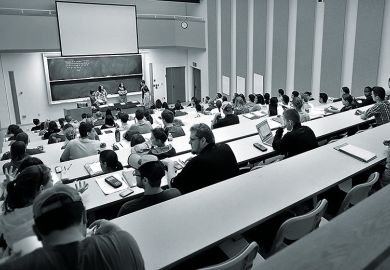You can’t move in higher education today without bumping into a student success strategy. Straddling the boundaries of student services and academic affairs, these blueprints lay out institutions’ intentions to support students’ academic progress and to help them build skills for jobs after graduation while also ensuring they feel that they belong at the institution.
The crowd of student success campaigns is partly a reflection of the surge in higher education enrolments in the past four decades. More students with more diverse backgrounds, varying levels of prior academic achievement and unique needs are now going to university or college. And institutions are scrambling to adapt.
They have made large investments in student success interventions and centres. There’s a growing field of dedicated professionals, from “student success coaches” to associate deans for advising and student belonging. Meanwhile, regulators and accreditors are holding institutions to account for student success in their standards and terms of registration.
Campus resource: What happens when we can’t help a student when they need us most?
But while the notion of student success obviously aligns with the mission of higher education, drawing a circle around what exactly it means is challenging, making measuring the effectiveness of the strategies tricky. Moreover, efforts to boost inclusivity are often not extended to the people most responsible for students’ success, their teachers and tutors.
While no one would argue with student success as an aspiration, there is, in short, considerable disagreement about how that aspiration should be pursued.
Many student success strategies are based on decades-old theories developed by higher education scholars such as Vincent Tinto, distinguished professor emeritus at the Syracuse University School of Education and author of the 1994 book Leaving College: Rethinking the Causes and Cures of Student Attrition. The meaning of student success, he says, depends on who is asking. “For the institution, success typically means the number of their entering students who finish degrees from the institution,” he says. State or national governments, meanwhile, will be focused on the success of students within their borders. But for the student themselves, “it has different meanings”, Tinto says. Some are focused on completion, either for its own sake or for its contribution to their employment aspirations. But for others “the object of higher education is [simply] learning, even if it does not lead to the completion of a degree”, Tinto says, referencing Bill Gates, a Harvard University dropout.
Tinto’s work on student belonging was inspired by Émile Durkheim’s theory that people’s integration – or lack of it – into a community influences their likelihood of dying by suicide. Although Tinto does not view attrition as a form of academic suicide, he says Durkheim’s work served as an analogy for intellectual and social integration, which affects whether students drop out or stay the course.
“It was a way of shedding light on the role institutions play in constructing, perhaps inadvertently, environments that discourage completion among students, as may be the case for students of different races, income and ethnicity,” he explains.
The influence of Tinto’s work is reflected in UK professional body Advance HE’s definition of student success in its online resource “Essential Frameworks for Advancing Student Success”. “What represents success for one student may not [do so] for another,” it says. “Individuals will have different motivations for, and expectations of, studying in HE and thus will want (as well as take) different things from the experience.”
According to the 2007 book Piecing Together the Student Success Puzzle: Research, Propositions and Recommendations, student success includes “academic achievement; engagement in educationally purposeful activities; satisfaction; acquisition of desired knowledge, skills and competencies; persistence; and attainment of educational objectives”. Co-author Jillian Kinzie, a senior research scientist at Indiana University Bloomington and interim co-director at the National Survey of Student Engagement (NSSE), says the definition still holds, but she would add “a high-quality learning environment” and “equitable learning” to it.
“The whole issue of equity has gotten so much more defined and is an absolutely essential part of any student success definition or objective today,” she says. A high-quality learning environment, according to Kinzie, is full of immersive and applied learning experiences, giving students the knowledge and skills expected by employers or wider society. “It’s not enough just to push students through a bunch of courses and a collection of credit hours,” she explains.
Since Kinzie and her colleagues wrote their book, “student success” has grown into a more defined goal “for the enterprise of higher education writ large. Everybody’s paying attention to those issues, and there’s no way to deny that they are influencing how we market and advertise what it is that we’re trying to do. But I also see institutions changing practice, so it’s not just spin,” she argues, citing the introduction of food banks on campuses as evidence of institutions’ commitment.
Not everyone, however, is convinced of the purity of universities’ intentions. For Chris Cunningham, an assistant lecturer and postgraduate student researching higher education at the University of Essex, student success – in England, at least – is about legitimising tuition fees. “Students expect to come out with a good degree because they’re paying for it. It’s the consumer culture,” he says. “Generally, a lot of institutions are aware of that, which is why there’s a lot of pressure to give students what they expect.”

In line with Tinto’s observation, degree outcomes certainly play a prominent role in how student success is seen by institutions. Student success initiatives in Australia, New Zealand and the UK are focused primarily on minimising student dropout rates amid “unacceptably high rates of attrition”, notes Karen Nelson, provost at the University of Southern Queensland and editor-in-chief of the journal Student Success. But she interprets universities’ motives more charitably than Cunningham does. “This focus on student success has been about institutions and leading individuals recognising that if we believe access to a university education should be a universal right, then we’ve got to change the way our institutions operate in order to fulfil the moral contract with the students we bring in,” she says.
Sara Goldrick-Rab, a higher education sociologist and independent scholar, also notes that while student success “is not a term that is very precise”, it typically boils down, in practice, to “does a student finish?” – which, “of course, is important, but it’s not by any means the only thing that matters”.
Even within that narrow definition, Goldrick-Rab laments the paucity of evidence that goes into institutional initiatives to boost student success, and she is doing her best to address it. For instance, while at Temple University’s Hope Center for College, Community, and Justice, which she founded, Goldrick-Rab co-authored a 2022 study into a trend among US institutions to give grants to final-year students to get them over the finish line. The study, funded by the US Department of Education and involving 11 open- and broad-access institutions, found that “completion grants”, as they are known, make no difference to graduation rates.
Goldrick-Rab does not conclude that the idea of completion grants is misguided, but she argues that universities’ methods of identifying the students most in need are flawed because of competing incentives: “[Administrators] are in a culture where one person says, ‘I want overall higher graduation rates’; another says, ‘But make sure the gaps [in pass rates between different student populations] are small’; and a third person, the CFO, says, ‘Watch your budget.’”
In Goldrick-Rab’s ideal scenario, vice-presidents of student success would make vice-presidents of institutional research their best friends. “I would treat the university like a laboratory in the most ethical way possible,” she says. Her experiments would include ongoing evaluation of the efficacy of formative and summative assessment, and her practices would include using control groups when rolling out scholarship or grant programmes.
Acquiring hard data on student success is also increasingly important to higher education accreditors and regulators. In 2022, the WASC Senior College and University Commission (WSCUC), a national accreditor of some 200 mostly US-based universities, amended several of its standards to include “student success objectives” alongside “educational objectives”. The shift came about because “the conversation around equity, diversity and inclusion had changed substantially since 2013 [when the standards were last changed],” says Jamienne Studley, president and CEO at WSCUC. The change mirrors how accreditation has moved its focus from inputs to outputs, she argues. “You could have two [higher education institutions] with comparable quality that get different results,” she says. “Then the conversation becomes, ‘What are the outcomes that matter to us, and are they being achieved consistently by students of different backgrounds in different fields?’”

WSCUC follows institutions’ leads on how to define student success and plans to measure it. “There are some things that can’t be measured with numbers, and there are some things that can be, some of which we have,” Studley says. “There are other things that can be measured with numbers but we don’t have them yet,” she adds. These include data on employment outcomes, debt-to-earnings ratios and employer satisfaction with graduates’ abilities, either technical (data skills, for instance) or personal (such as getting along with colleagues).
Measured by graduation rates, US student success is certainly improving. Of the students who entered a four-year university in 1996, 33 per cent graduated in four years. That figure rose to 46 per cent for students who entered in 2014 (the Organisation for Economic Cooperation and Development average is 38 per cent). However, rates still vary widely by ethnicity. While 67 per cent of white students who entered in 2014 obtained their bachelor’s degrees within six years, only 45 per cent of black and 59 per cent of Hispanic students did.
“While we have increased graduation rates of students who have not done well in the past, we haven’t addressed important questions of equity,” says Tinto. “Though some institutions have made progress, most have not.”
Similar disparities exist in the UK. The completion rate for black students, for example, was 7.8 percentage points lower than that for white students in 2021-22. And the rates for students from the poorest postcodes were 6.7 percentage points lower than those in the wealthiest.
Completion rates form part of the basis for the student outcomes thresholds controversially announced last September by England’s Office for Students (OfS): 75 per cent of full-time students pursuing a first degree should complete their course, the regulator specifies. In addition, 80 per cent should progress to the next year of their studies and 60 per cent should go on to “further study, professional work, or other positive outcomes” within 15 months of graduating. Universities and colleges that perform below these thresholds could face sanctions for being in breach of their terms of registration.
John Blake, director for fair access and participation at the OfS since 2021, is responsible for making sure institutions meet the thresholds. The metrics have been criticised by sector leaders for being too narrow and simplistic, but while Blake acknowledges that “there are some people whose success will still occur outside of those outcomes, for the majority of students, the reason they go to higher education is because they will learn something. They want to succeed and they want to progress to a graduate-level career.”
This is also why graduate earnings – however much they may vary by field and geography – also loom large in student success metrics, representing one of the easiest ways for students, politicians and the public to assess the value of higher education. In her previous role as deputy undersecretary of the US Department of Education, WSCUC’s Studley helped to develop the College Scorecard, which includes graduate earnings data. And she says that if universities don’t like such metrics, they have only themselves to blame.
“Higher education did itself a terrible disservice many years ago when it said that you make a million dollars more over your lifetime if you get a bachelor’s degree,” she says. “That became the billboard and the bumper sticker, and it rotated the conversation in a direction that was not helpful because that’s not all there is [to student success].”
Studley says that in developing the College Scorecard, policymakers and administrators got better at asking questions about student success, and the data increasingly became available to answer them, including information from the Department of the Treasury. “But it is a circle. As you talk about the value of college and dig deep to try and get at it, you uncover the flaws as well as the successes.”
The NSSE’s Kinzie worries that there can be an over-reliance on post-graduation income in assessing student success. “We need to make sure that people make a living wage, but are we really just after college graduates that make this much more [money] than people without a college degree? That’s not really the goal here. We’re not trying to create wage disparities across the world.”
But while US institutions are also using indicators such as course retention rates and proportion of failing grades to inform action on campus, they are still in the early days of developing other measurements, she argues. The NSSE, for example, provides measurements on “high-impact practices”, such as how many opportunities for internships and undergraduate research students have. And in 2020, Kinzie and her team altered the survey in an attempt to measure students’ sense of belonging. “The whole idea is to ask students about things [about which] colleges and universities can say ‘It isn’t acceptable to us to have it at this level. We need to probe to see what’s contributing to [it],” she says.
For Southern Queensland’s Nelson, too, looking beyond graduation and attrition rates is crucial. For her, the next step in the professionalisation of student success would be for institutions to assess their own practices against a common set of predetermined metrics. “We collect a lot of data about student outcomes and self-reported data from students about their experiences, but there’s not a complementary dataset saying, ‘These are the things that institutions should be doing and this is how mature they are in their practice,’” she says. That type of data, she argues, would show that some institutions are making a big difference, while others may not see such good results.
Meanwhile, the fate of student success initiatives is hugely dependent on academics. But top-down strategies to monitor students’ progress have stoked existing tensions between faculty and administrators and, some critics claim, placed added pressure on a precarious workforce.
According to the National Center for Educational Statistics, 44.2 per cent of US faculty were part-time employees in 2021. And in the UK, Higher Education Statistics Agency figures show that in 2021-22, 35 per cent of academic staff were part-time, with 37 per cent of those paid by the hour.
And for all the efforts to make students feel that they belong on campus, part-time faculty are often deprived of the same attention. For seven years, Erik Swanson would travel between Washington DC and Pennsylvania to teach part-time at several community colleges before becoming a full-time professor at Montgomery College in Maryland. Nor was he alone: “We were the [Washington] Beltway bandits – going from one institution to another just trying to make ends meet,” he says.
In terms of help with class preparation, “the best I would get would be an old syllabus – and sometimes I wasn’t even given that,” he recalls. One time he had to sit through a full-time professor’s class in the daytime to know what to teach in the same class that evening. Yet student success strategies were still imposed on him and other adjunct faculty.
Swanson is now the interim director of the Institute for Part-time Faculty Engagement & Support at Montgomery. He praises the institution for “being aggressive” about training adjunct faculty, providing them with fellowships, training conferences and physical spaces to work on campus. Without such measures, student success, in his view, is just a hollow catchphrase.
It isn’t just that neglected contingent faculty chafe against the unfairness of student success initiatives when there is no equivalent effort to take account of their own difficulties. In his 2006 paper “Effects of part-time faculty employment on community college graduation rates”, Dan Jacoby, professor emeritus at the University of Washington, found that student failure rates correlated with higher part-time/full-time faculty ratios. He concluded that low graduation rates “are the consequence of multiple disincentives inherent in current part-time faculty contracting”.
Jacoby’s research doesn’t pinpoint which aspects of the part-time work environment contribute to lower graduation rates, but he suggests that faculty transience makes it difficult to build relationships with students. “Sometimes [adjunct] faculty aren’t even listed in the directory, so you can’t find their phone numbers,” he says. His research quashed theories that poor teaching from part-time faculty in community colleges resulted in lower graduation rates, but the tendency to blame adjuncts persists, he says.
For his part, Swanson admits that the pressure to progress students on to the next class seeped into how he thought about grading as an adjunct. “That fear was always in the back of your head: ‘If I hit them hard and I have a lot of DFW rates [grades D, F or withdrawal], is that going to impact me?’”
Swanson says the “aha moments” of teaching, when he really connects with students, usually happen outside the classroom. “I think those conversations can only happen in office spaces. But when you’re an adjunct and you’re sleeping in your car or you’re teaching out of your trunk, you can’t do that,” he says.
Faculty in the UK are struggling in similar environments, according to Essex’s Cunningham. For him, real student success is synonymous with learning – but the current system doesn’t allow academics to cultivate learning communities.
“You’ve got an increase in student numbers; you’ve got a higher workload. There’s no time to build those relationships. Everyone has to quantify everything. That opportunity for genuine student success has been eroded through that quantified process,” he says.
Student success initiatives run up against another age-old higher education issue, too: academics’ dislike of having their teaching “interfered” with by administrators – particularly when it makes extra work for them.
Stone Meredith, an adjunct faculty member at four institutions in the US – three public, one private – defines student success as “a mishegoss [madness] of record-keeping, tracking and checking-in right across the board”. She says workloads have increased along with pressures to do institutional research on behalf of universities and growing interventions from student success advisers. “I’ve gotten an edict that this student success person is going to be going down a checklist of things and coming in to watch me to see if I do this,” she says.
She accepts that student success advisers have students’ best interests in mind, but she blames institutional leaders for failing to ensure that advisers and faculty know how to work together. “It’s like two mules fighting over a turnip,” she says – with the student being the turnip. “There’s real potential here, but you have got to trust the [academics] who do the work. They’ve hired people above us to tell us what to think instead of letting us partner and show what we know.”
The frustration is felt from the other side of the faculty-administrator divide, too. The University of Leeds recently published its “Access and Student Success Strategy 2025”, aiming to “create a university where students feel they belong, can thrive, and are valued for their unique contribution”. Deputy vice-chancellor for student education Jeff Grabill says the institution’s education strategy has been “deeply shaped” by its key performance indicators for student success, an example being its aspiration to reduce the gap between the proportions of white versus black, Asian and minority ethnic (BAME) undergraduates awarded first-class and upper-second-class degrees, and to eliminate it by 2030.
Leeds endeavours to train faculty and staff in furthering student success and also aims to hire more from BAME backgrounds to reflect the local community and sector averages. This approach is taking student success interventions a step further, argues Grabill, who is the former associate provost for teaching, learning and technology at Michigan State University. “Where the work in the US has tended to flounder, if not stop, is once it touches what and how we teach. I think that’s the really hard part.”
Hard because it involves engaging with academics who “are a little less open to changing how they work than professional staff”, says Grabill. “We find ourselves in a position where we’re sitting down with the school and saying, ‘We think the way in which what you’re teaching and how you’re teaching it is systemically producing poor outcomes.’”
Such conversations are undoubtedly difficult to have. But with the issues afflicting student success only increasing, they are necessary, Grabill says. A generation of students whose lives were significantly disrupted by the Covid pandemic are now entering higher education with even more heterogeneous learning experiences and needs than previous cohorts.
“The students that we have right now and into the near future are just different from the students that we’ve had in the past,” says Grabill. “They need different things from us. The real challenge for us is to slow down and listen to them and to try to meet them where they are.”
Register to continue
Why register?
- Registration is free and only takes a moment
- Once registered, you can read 3 articles a month
- Sign up for our newsletter
Subscribe
Or subscribe for unlimited access to:
- Unlimited access to news, views, insights & reviews
- Digital editions
- Digital access to THE’s university and college rankings analysis
Already registered or a current subscriber? Login








